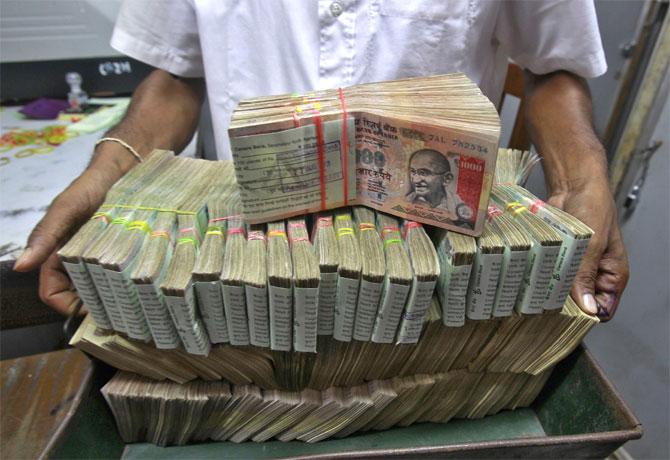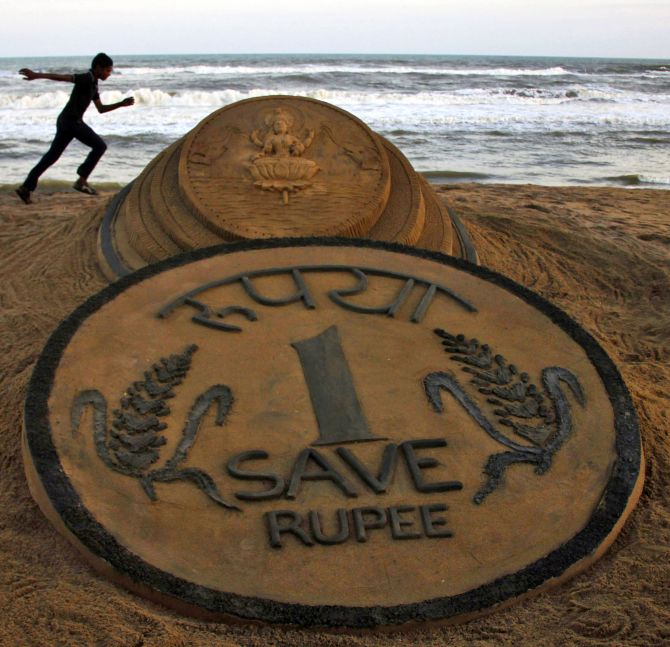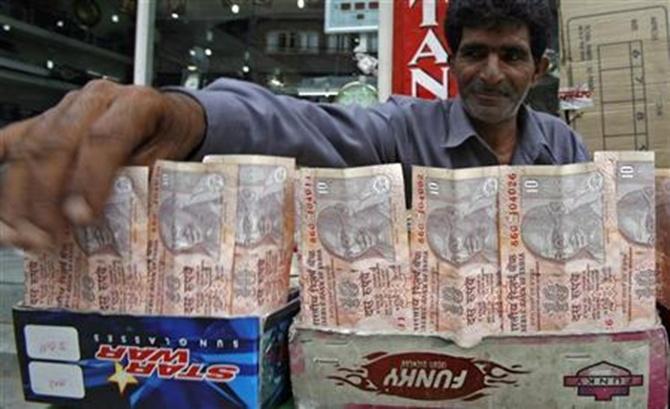 | « Back to article | Print this article |
How the government can stabilise the rupee
The author explains how the government could make a real difference in the financial markets.
Let me cut to the chase. What are the options left for the government to bring some stability back to the rupee?
What are the short-term fixes, and the somewhat longer-term policies, that could help achieve this?
Two things need to be emphasised at the very beginning. First, the shortage of capital flows into emerging markets is unlikely to go away in a hurry.
The United States Federal Reserve might or might not taper in September and an initial taper could indeed be baked into the emerging market currency exchange rates vis-à-vis the dollar.
However, it seems certain that the Fed will start winding quantitative easing down by the end of the year - and whatever the pace of the taper, the infusion of dollar liquidity will keep reducing over 2014. Thus, India and other emerging markets have to be ready for a long dry season ahead.
Second, the option of simply "growing" ourselves out of this problem is limited. Better execution of projects and a more conducive investment environment (difficult to achieve when elections lie ahead) might improve sentiment towards India and invite capital flows, but there is a risk of growth stretching the current account deficit wider.
Click NEXT to read more...
How the government can stabilise the rupee
One should certainly not depend on the central bank reducing rates sharply even if the rupee shows some sign of stability.
It would take an extremely adventurous Reserve Bank of India (RBI) governor to cut interest rates sharply when the current account deficit seems likely to print at four per cent of GDP and there is a clear risk of diminished capital inflows.
As US Treasury yields move up on the back of tighter monetary policy, our central bank will have to ensure that there is an arbitrage window (adjusted for risk) that keeps debt flows coming in and funds the deficit. That seems to obviate drastic reductions in interest rates for a while to come.
Thus, there is a fine balancing act: we cannot afford further deceleration in the economy as that itself would impede capital flows, but any attempt to boost the economy at this stage will also have to be handled carefully.
Let me get to the short-term fixes. The myriad announcements by the finance minister to raise dollars through quasi-sovereign bond issues and commercial borrowings by oil marketing companies (OMCs) have failed to do the trick simply because they remain promises on which there has been no actual delivery.
Click NEXT to read more...
How the government can stabilise the rupee
The assumption that these measures would somehow get priced into the exchange rate ahead of the actual flows has proved wrong. The market has clearly indicated that it would like to see the money before it starts selling the dollar. Thus, some of this proposed fund raising needs to be done somewhat urgently for this strategy to be credible.
The recent episode of depreciation has clearly been led by off-shore non-deliverable forwards (and options) markets where entities like hedge funds and proprietory desks of multinational banks place their bets.
The non-deliverable forwards market has taken the lead in setting the exchange rate and the domestic market has played catch-up. The central bank's intervention in the local market has consequently not worked. Thus, the RBI has to find a way of directly intervening in this market.
I am not sure if this is possible, but in the very near term there could be an option of intervening with the help of other central banks that are known to have intervened in this market - like the Korean or Indonesian central banks.
The RBI typically intervenes in the local markets through state-run banks and, thus, there is a strong case, going forward, to allow at least these banks (if not all Indian banks) to operate in the non-deliverable forwards market.
Click NEXT to read more...
How the government can stabilise the rupee
I like the idea of aligning the means to the ends. Getting public sector undertakings to issue bonds in the international markets to bring in dollars raises legitimate questions about why these independently run companies should pitch in to ensure macroeconomic stability.
What are the costs they need to bear in terms of more debt on their books and the stream of interest payments that follow? If the objective is to stabilise the rupee and shore up reserves, then the government needs to use instruments that meet this specific goal.
One could justify a sovereign bond issue from this perspective. But that is not the only instrument available. The currency is in a sense the RBI's baby. Thus, it might make sense for the central bank to float "stabilisation" bonds for this purpose.
The market for this could be limited to other central banks and quasi-sovereign institutions, and will fetch the RBI the short-term firepower to stem the rupee's slide.
Again, as a number of editorials in this newspaper have suggested, we urgently need to shed our phobia about the International Monetary Fund (IMF) and work towards getting at least a precautionary credit line from the global lender of last resort.
This could work wonders in bringing a sense of preparedness and calm to the rupee market. The stigma attached to a borrowing from the IMF and its adverse political consequences seem to be a little exaggerated.
Click NEXT to read more...
How the government can stabilise the rupee
Friends at some multilaterals tell me the IMF would be willing to lend with far less restrictive conditions than it did in the 1990s (although there has to be some collateral like gold) and, thus, the idea of bartering our sovereignty for a fistful of dollars is just stuff and nonsense.
Finally, the swap facility offered to OMCs could make a significant difference to the exchange rate - but only if certain conditions are met. It is important to remember that this is a swap arrangement and not an outright dollar sale from reserves.
This means that OMCs getting into the contract run the risk of having to buy dollars at an unfavourable exchange rate when they have to deliver dollars back to the RBI. This risk could be mitigated if the RBI implicitly commits to roll the swaps over if the exchange rate is unfavourable.
Perhaps it has made this commitment; and if OMCs do fund some of their imports through this route, it could make a significant difference to the demand-supply balance. Daily oil imports, incidentally, average $500 million.
The writer is with HDFC Bank. These views are personal.





